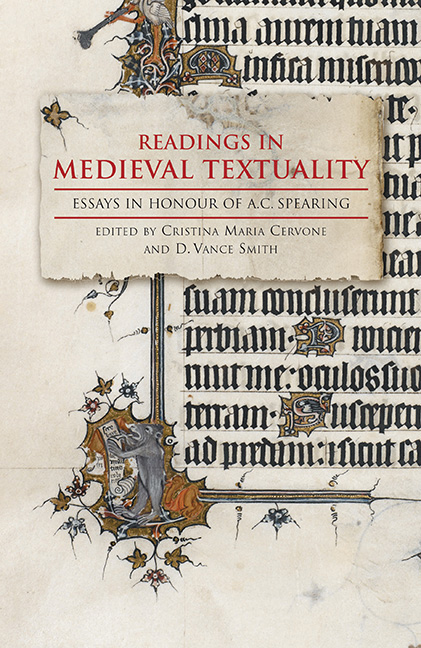Book contents
- Frontmatter
- Contents
- List of Illustrations
- List of Contributors
- A. C. Spearing's Work and Influence
- Bibliography of A. C. Spearing's Works
- I Reading Experience and Experientiality
- II Revisions and Re-visioning of Alliterative Poetry
- III Subjectivity and the Self
- 6 Re-reading Troilus in Response to Tony Spearing
- 7 The English Charles: Subjectivity, Texts and Culture
- IV Reading for Form
- V Epilogue
- Works Cited
- Index
- Tabula Gratulatoria
7 - The English Charles: Subjectivity, Texts and Culture
from III - Subjectivity and the Self
Published online by Cambridge University Press: 25 October 2017
- Frontmatter
- Contents
- List of Illustrations
- List of Contributors
- A. C. Spearing's Work and Influence
- Bibliography of A. C. Spearing's Works
- I Reading Experience and Experientiality
- II Revisions and Re-visioning of Alliterative Poetry
- III Subjectivity and the Self
- 6 Re-reading Troilus in Response to Tony Spearing
- 7 The English Charles: Subjectivity, Texts and Culture
- IV Reading for Form
- V Epilogue
- Works Cited
- Index
- Tabula Gratulatoria
Summary
In the last few years Tony Spearing has conducted a sustained and characteristically wide-ranging campaign against the idea that the medieval literary speaker and narrator should be thought of as a “self-consistent imaginary person.” Spearing also notes that, although the idea of a distinct and internally coherent “I” has long been associated with later autobiographical and fictional literature, consensus about such a figure disappears in much twentieth-century writing; more important, Spearing also observes that such an “I” is in fact always pressured by internal tensions and contradictions. And so, when he argues that it must be a mistake to read medieval literary subjectivity as even in transition towards some hypothetical later “monadic” subject he is surely right.
But he is in no doubt that there is such a thing as medieval literary subjectivity. For him, however, this subjectivity is indelibly (inter)textual and inseparable from the writings in which it is “encoded”: in Medieval Autographies, invoking Derrida and de Man, but also critics such as Lisa Samuels and Jeanne Perreault, Spearing identifies in medieval speaker/narrator/writer figures not an autobiographical subject, but an “autographic” one – a bricolage figure who is characterized by discontinuity and permeated by the discursive and writerly inheritance. He locates this autographic subject in the “I”-shaped literature of the Middle Ages, whose characteristic form he identifies as the originally French genre of the dit (“saying,” “poem”), a multifarious and fluid poetic genre nevertheless written in the first person. Here, he says, “writing creates the effect of speech while always keeping us aware of its writtenness.” The dit is
a textual performance that has the discontinuous nature of a compilation … or bricolage. It may stage an “I,” but it does not stage a unitary consciousness, because it tends to include much that is quoted and much that in other ways is not represented as having been processed by the “I.”
Spearing goes on to exemplify this “writtenness” with various examples from later medieval French and English literature written in the first person, where the “I” speaks in forms derived from anterior literary models, articulates concerns that seem to be those of the author, tells us things that, naturalistically, the “I” should not have known, and ventriloquizes characters’ views and attitudes in the modes of free indirect speech.
- Type
- Chapter
- Information
- Readings in Medieval TextualityEssays in Honour of A.C. Spearing, pp. 97 - 116Publisher: Boydell & BrewerPrint publication year: 2016

